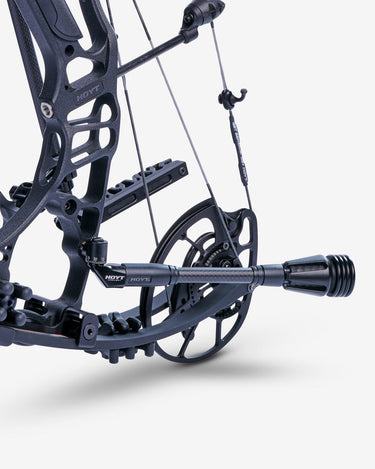Attain Constant Shots with the Right Bow Stabilizer: Store Our Choice Today!
Attain Constant Shots with the Right Bow Stabilizer: Store Our Choice Today!
Blog Article
Maximize Your Archery Precision With These Bow Stabilizer Strategies
One vital component that can dramatically influence your efficiency is the correct use of bow stabilizers. Whether you are a skilled archer looking to refine your abilities or a newcomer anxious to enhance your accuracy, understanding these bow stabilizer strategies can be the key to hitting your mark with exceptional consistency.
Advantages of Utilizing Bow Stabilizers
Utilizing bow stabilizers can substantially boost an archer's precision and overall performance by lessening bow torque and resonance. Furthermore, bow stabilizers wet resonance, which not only improves the comfort of capturing but additionally avoids the bow from jumping upon launch, therefore aiding in maintaining appropriate aim.
Furthermore, bow stabilizers can help in holding the bow constant, particularly throughout windy conditions or when shooting from longer distances. The included weight at the front of the bow supplies stability and equilibrium, allowing the archer to concentrate on intending without the diversion of bow movement. Generally, the advantages of utilizing bow stabilizers extend past simply precision, improving the archer's experience and performance in various shooting scenarios.
Selecting the Right Bow Stabilizer
Picking the proper bow stabilizer is critical for enhancing your archery equipment and boosting shooting efficiency. When choosing a bow stabilizer, there are several factors to consider to guarantee you discover the best suitable for your demands. Think about the weight of the stabilizer. Larger stabilizers can help in reducing bow torque and absorb even more resonance, leading to a steadier purpose. However, lighter stabilizers supply more ability to move, which can be valuable in specific shooting situations.

Lastly, consider the style of the stabilizer. Some stabilizers come with flexible weights or dampeners that permit you to tailor the balance and feeling of your bow. Eventually, selecting the appropriate bow stabilizer involves locating an equilibrium between weight, layout, material, and size to boost your shooting precision and total efficiency.
Appropriate Installation Strategies
To make certain ideal efficiency and safety and security in archery, understanding correct installation strategies for your bow stabilizer is important. The primary step in setting up a bow stabilizer is to determine the right placement on your bow. Most stabilizers are connected to the front of the riser, below the grasp, to help counterbalance the weight of accessories such as quivers and views. Guarantee that the stabilizer is not interfering with various other elements or preventing your capturing type.
Following, safely affix the stabilizer to the bow utilizing the appropriate placing hardware. Some stabilizers come with flexible weights that can be added or gotten rid of to adjust the equilibrium of your bow.

Adjusting Stabilizer Weight and Size
After ensuring the appropriate installment of your bow useful site stabilizer, the following action includes changing the weight and length to maximize its efficiency in improving archery accuracy. The weight of the stabilizer plays an essential role in lessening bow movement throughout the shot cycle. Including weight to the stabilizer can website here aid boost and wet resonances stability, bring about even more constant and exact shots. On the various other hand, minimizing the weight can raise ability to move, which is advantageous for situations needing fast target purchase.
When it comes to stabilizer length, locating the best equilibrium is vital. A longer stabilizer can give higher security by enhancing the distance between the bow and the weight at the end of the stabilizer. This added distance improves the supporting impact, specifically in gusty problems or when contending longer distances. Conversely, a much shorter stabilizer uses much more ability to move and may be favored by archers who value agility and quick movements throughout shooting.
Advanced Stabilizer Tuning Tips
Attaining optimal bow security and accuracy in archery requires a nuanced method to sophisticated stabilizer adjusting. Advanced stabilizer tuning includes fine-tuning various components to enhance the bow's equilibrium, decrease vibration, and boost overall accuracy. One vital strategy is to explore different stabilizer arrangements, including back-bar and side-bar arrangements, to locate the optimal balance between security and ability to move for your capturing style. bow stabilizer. Additionally, adjusting the angle and positioning of the stabilizer can have a considerable influence on exactly how the bow responds upon release.
Another crucial element of advanced stabilizer adjusting is optimizing the damping residential properties of the stabilizer system. This can be accomplished by integrating added dampening accessories such as rubber dampeners or harmonic stabilizers to even more lower resonance and noise. Exploring different products for the stabilizer building and construction, such as carbon fiber or aluminum, can also affect the bow's performance by modifying its weight circulation and browse around this site tightness. By carefully make improvements these innovative stabilizer components, archers can maximize their accuracy and consistency on the range or in competition.
Conclusion
In verdict, optimizing archery precision can be attained with the appropriate option, installation, and adjustment of bow stabilizers. Overall, incorporating bow stabilizers right into archery technique can lead to improved efficiency and boosted accuracy.
Making use of bow stabilizers can considerably improve an archer's accuracy and overall performance by reducing bow torque and vibration. Longer stabilizers supply greater security and balance, specifically for long-distance capturing, while shorter stabilizers offer even more adaptability and are simpler to maneuver in tight spaces (bow stabilizer). Carbon fiber stabilizers are lightweight and resilient, while light weight aluminum stabilizers are robust and give superb vibration moistening
A longer stabilizer can offer better stability by increasing the distance in between the bow and the weight at the end of the stabilizer.One more important facet of advanced stabilizer adjusting is maximizing the damping residential properties of the stabilizer system.
Report this page